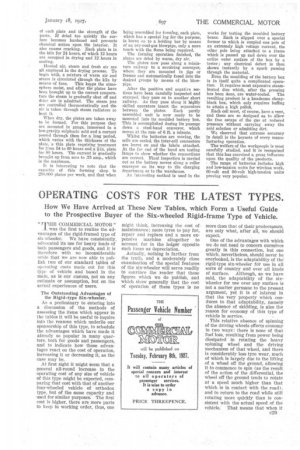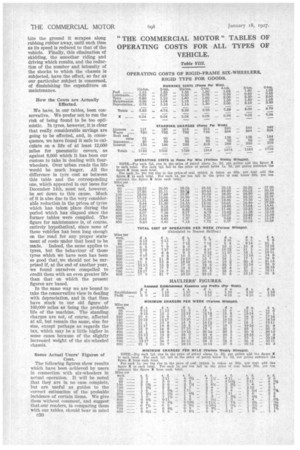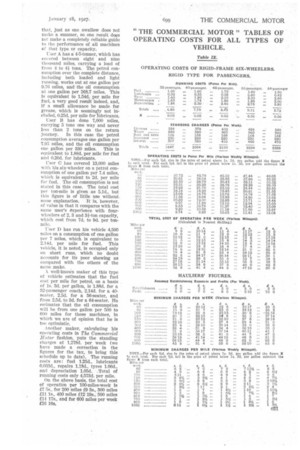OPERATING COSTS FOR THE LATEST TYPES.
Page 51

Page 52

Page 53

If you've noticed an error in this article please click here to report it so we can fix it.
How We Have Arrived at These New Tables, which Form a Useful Guide to the Prospective Buyer of the Six-wheeled Rigid-frame Type of Vehicle.
" MHE COMMERCIAL MOTOR"
1 was the first to realize the advantages of the rigid-framed type of six-wheeler. We have consistently. advocated its use for heavy loads of both passengers and goods, and it is therefore with no inconsiderable oride that we are now able to publish two of our standard tables of operating Costs made out for this type of vehicle and based in the main, as is our custom, not on any estimate or assumption, but on the actual experiences of users.
The Outstanding Advantages of the Rigid-type Six-wheeler.
As a preliminary to entering into a discussion of the methods of assessing the items which appear in the tables it will be useful to inquire into the reasons which underlie our sponsorship of this type, to schedule the advantages which have made it already so popular in many quarters, both for goods and passengers, and to indicate how those advantages react on the cost of operation, Increasing it or decreasing it, as the case may be.
At first sight it might seem that a general all-round increase in the operating cost of any size of vehicle of this type might be expected, comparing that cost with that of another four-wheeled vehicle of orthodox type, but of the same capacity and used for similar purposes. The first cost is higher, there are more parts to keep in working order, thus, one might think, increasing the cost of maintenance; more tyres to pay for, repair and replace and a more expensive machine altogether to account for in the ledger opposite such items as depreciation.
Actually, nothing is farther from the truth, and a moderately close examination of the special features of the six-wheeler will serve readily to convince the reader that those figures which we do publish, and which show generally that the cost of operation of these types is no more than that of their predecessors, are only what, after an, we should expect.
One of the advantages with which we do not need to concern ourselves greatly in this connection, but one which, nevertheless, should never be overlooked, is the adaptability of the rigid-type six-wheeler for use in all sorts of country and over all kinds of surface. Although, as we have said, the adaptability of the sixwheeler for use over any surface is not a matter germane to the present argument, yet It is of interest in that the very property which conduces to that adaptability, namely the absence of skidding, is also the reason for economy of this type of vehicle in service.
This relative absence of spinning of the driving wheels effects economy in two ways: there is none of that fuel loss, resulting from power being dissipated in rotating the heavy spinning wheel and the driving mechanism of that wheel, and there is considerably less tyre wear, much of which is largely due to the lifting of a wheel oft the ground, allowing it to commence to spin (as the result of the action of the differential, the wheel off the ground tends to rotate at a speed much higher than that which is in contact with the road). and to return to the road while still rotating more quickly than is consistent with the actual speed of the vehicle. That means that when it
hits the ground it scrapes along rubbing rubber away, until such time as its speed is reduced to that of the vehicle. Finally, this elimination of skidding, the smoother riding and driving which results, and the reduction of the number and intensity of the shocks to which the chassis is subjected, have the effect, so far as our particular subject is concerned, of diminishing the expenditure on maintenance.
How the Costs are Actually Effected.
We have, in our tables, been conservative. We prefer not to run the risk of being found to be too optimistic. In tyres, however, it is clear that really considerable savings are going to be effected, and, in consequence, we have found it safe to calculate on a life of at least 12,000 miles for pneumatic covers, as against 8,000 which it has been our custom to take in dealing with fourwheelers. Over urban roads the life would be much longer. All the difference ha tyre cost as between this table and the corresponding one, which appeared in our issue for December 14th, must not, however, be set down to this cause. Much of it is also due to the very considerable reduction in the prices of tyres which has taken place during the period which has elapsed since the former tables were compiled. The figure for maintenance is, of course, entirely hypothetical, since none of these vehicles has been long enough on the road for any proper statement of costs under that head to be made. Indeed, the same applies to tyres, but the behaviour of those tyres which we have seen has been so good that,we should not be surprised if, at the end of another year, we found ourselves compelled to credit them with an even greater life than that on which the present figures are based.
In the same way we are bound to take the conservative view in dealing with depreciation, and in that item have stuck to our old figure of 160,000 miles as being the probable life of the machine. The standing charges are not, of course, affected at all, but remain the same, size for size, except perhaps as regards the tax, which may be a little higher in some cases because of the slightly increased weight of the six-wheeled chassis.
Some Actual Users' Figures of Cost.
The following figures show results which have been achieved by users in connection with six-wheelers in actual operation. It will be noted that they are in no case complete, but are useful as guides to the correct estimation of the probable incidence of certain items. We give them without comment, and suggest that-our readers, in comparing them with our tables, should bear in mind that, just as one swallow does not make a summer, so one result does not make a completely reliable guide to the performance of all machines of that type or capacity.
'User A has a 4-5-tonner, which has covered between eight and nine thousand miles, carrying a load of from 4 to 41 tons. The petrol consumption over the complete distance, including both loaded and light running, works out at one gallon per 9.76 miles, and the oil consumption at one gallon per 268.7 miles. This is equivalent to 1.54d. per mile for fuel, a very good result indeed, and, if a small allowance be made for grease, which is seemingly not included, 0.25d. per mile for lubricants.
User B has done 7,000 miles, carrying 5 tons one way and never less than 2 tons on the return journey. In this case the petrol consumption averages one gallon per 7.95 miles, and the oil consumption one gallon per 330 miles. This is equivalent to 1.88d. per mile for fuel and 0.20th for lubricants.
User C has covered 13,000 miles with his six-wheeler on a petrol consumption of one gallon per 7.4 miles, which is equivalent to 2d. per mile for fuel. The oil consumption is not stated in this case. The total cost per ton-mile is given as 5.1d., but this figure is of little use without, some explanation. It is, however, of value in that it compares with the same user's experience with fourwheelers of 2, 3 and 31-ton capacity, which cost from 7d. to 9d. per tonmile.
-User D has run his vehicle 4,500 miles on a consumption of one gallon per 7 miles, which is equivalent to 214d. per mile for fuel. This vehicle, it is noted, is occupied only on short runs, which no doubt accounts for its poor showing as compared with the others of the same make.
A. well-known maker of this type of vehicle estimates that the fuel cost per mile for petrol, on a basis of Is. 3d. per gallon, is 1.88d. for a 32-passenger coach, 2.14d. for a 40seater, 2.5d. for a 56-seater, and from 2.5d. to 3d. for a 64-seater. He estimates that the oil consumption will be from one gallon per 500 to 600 miles for these machines, in which we are of opinion that he is too optimistic.
Another maker, calculating his operating costs in The Commercial Motor fashion, puts the standing charges at 1,278th per week (we have made a correction in the figures for the tax, to bring this schedule up to date). The running costs are: fuel 1.25d., lubricants 0.033d., repairs 1.18d., tyres 1.06d., and depreciation 1.05d. Total of running costs only 4.573th per mile.
On the above basis, the total cost of operation per 100-miles-week is £7 5s., for 200 miles £9 3s., 300 miles £11 Is., 400 miles £12 19s., 500 miles £14 17s., and for 600 miles per week ile les.












































































































